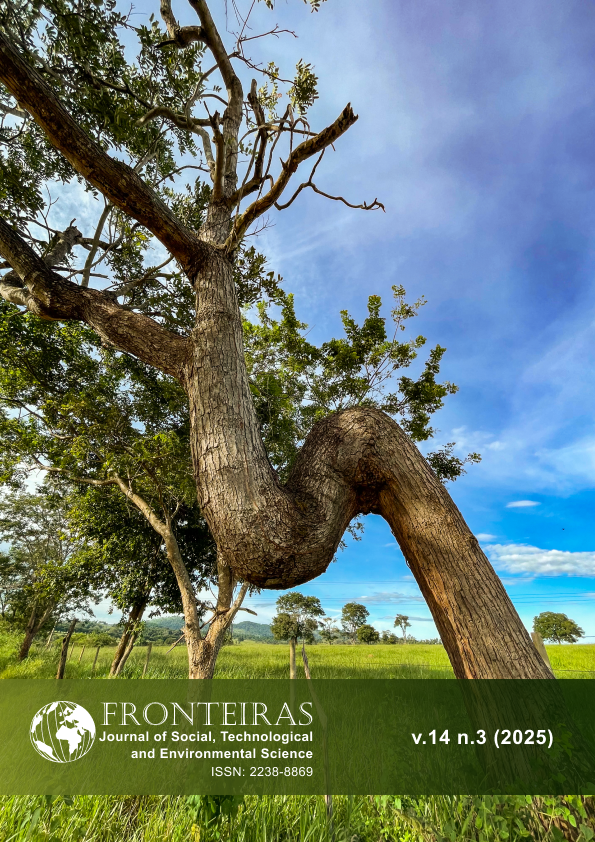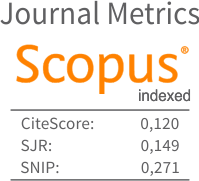Living with Water, Learning From it: Rural Educational Practices around Disasters in the Lower Salado River Basin (Province of Buenos Aires, Argentina). A Case Study
DOI:
https://doi.org/10.21664/2238-8869.2025v14i3.7973Keywords:
rural education, CEPT, droughts, floods, Salado riverAbstract
Rural educational environments in the province of Buenos Aires are affected by hydro-social processes that transform and dynamise the territory, such as droughts and floods. CEPTs (Centros Educativos para la Producción Total, one of the modalities of agricultural education in the province of Buenos Aires) are not left out of these processes by including in their curricula tools such as Production Notebooks, Research Plans and Theses, which can motivate the study of such disasters. Through the development of these tools, the educational community manifests the productive and social impact of droughts and floods, together with the existence of local knowledge and generational coping practices. Therefore, the general objective of this paper is to examine, through a case study, how students in a rural school in Buenos Aires rebuild the socio-territorial capital of their community (a fundamental aspect for the construction of resilient communities) through territorially anchored educational practices. The research will focus on CEPT No. 28 Paraje ‘La Unión’ in the district of General Guido, founded in 2008 and noted for its continuity and interest in the subject. Following the social sciences paradigm in the study of disasters, the school will be taken as a central place of rural sociability in order to understand droughts and floods comprehensively and as processes. The methodological design of the article is qualitative, based on the analysis of the aforementioned tools, and complemented with in-depth interviews with the teaching and management staff and an experience of participant observation in the institution.
References
Barsky O, Dávila M, Busto Tarelli, T 2009. Educación y desarrollo rural. La experiencia de los centros educativos para la Producción Total CEPT. Ciccus, Buenos Aires, 264 pp.
Bell I, Laurie N, Calle O, Carmen M, Valdez A 2024. Education for disaster resilience: lessons from El Niño. Geoforum, 148. https://doi.org/10.1016/j.geoforum.2023.103919
Boelens R, Hoogesteger J, Swyngedouw E, Vos J. Wester P 2016. Hydrosocial territories: a political ecology perspective. Water International, 41(1): 1-14. https://doi.org/10.1080/02508060.2016.1134898
Bourdieu P 1980. Le capital social. Actes de la recherche en sciences sociales, 31: 2-3. www.persee.fr/doc/arss_0335-5322_1980_num_31_1_2069
Camagni, R, Capello R 2013. Regional Competitiveness and Territorial Capital: A Conceptual Approach and Empirical Evidence from the European Union. Regional Studies, 47(9): 1383–1402. https://doi.org/10.1080/00343404.2012.681640
Cheshire L, Pérez JE, Shucksmith M 2015. Community resilience, social capital and territorial governance. Journal of depopulation and rural development studies, (18): 7-38.
Cieza, RI 2020. Transformaciones productivas en la Cuenca del Salado y persistencia de la ganadería familiar (1999-2019). Ciencias Agronómicas, 36(20). https://doi.org/10.35305/agro36.295
Gaillard, JC 2010. Vulnerability, capacity and resilience: Perspectives for climate and development policy. Journal of International Development, 22(2): 218–232. https://doi.org/10.1002/jid.1675
Gutiérrez T 2022. Centro Educativo para la Producción Total (CEPT) en A Salomón, J Muzlera. Diccionario del Agro Iberoamericano.Teseo Editores, Buenos Aires. 1346 p. https://www.teseopress.com/diccionarioagro/chapter/centro-educativo-para-la-produccion-total-provincia-de-buenos-aires-argentina-1988-2019footnote-recibido-julio-2019-footnote/
Linton J 2014. Modern water and its discontents: a history of hydrosocial renewal. Wiley Interdisciplinary Reviews: Water, 1(1): 111-120. https://doi.org/10.1002/wat2.1009
Maresca S, Quiroz García, JL y Plorutti F 2011. Eficiencia reproductiva en rodeos de cría de la Cuenca del Salado. Ediciones INTA, Buenos Aires, 27 pp. https://repositorio.inta.gob.ar/xmlui/bitstream/handle/20.500.12123/5474/INTA_CRBsAsSur_EEACuencadelSalado_Maresca_S_Eficiencia_reproductiva_rodeos_cria_Cuenca_Salado.pdf?sequence=1&isAllowed=y
MINFRA – Ministerio de Infraestructura y Servicios Públicos de la provincia de Buenos Aires 2020. Atlas de cuencas y regiones hídricas-ambientales de la provincia de Buenos Aires. Etapa 1. https://www.minfra.gba.gov.ar/web/Hidraulica/Atlas.pdf
Mitchell T, Haynes K, Hall N, Choong W, Oven K 2008. The roles of children and youth in communicating disaster risk. Children, youth and environments, 18(1): 254-279.
Mochizuki J, Keating A, Liu W, Hochrainer-Stigler S, Mechler R 2017. An overdue alignment of risk and resilience? A conceptual contribution to community resilience. Disasters, 42(2): 361–391. https://doi.org/10.1111/disa.12239
Norris FH, Stevens SP, Pfefferbaum B, Wyche KF, Pfefferbaum RL 2008. Community resilience as a metaphor, theory, set of capacities, and strategy for disaster readiness. American Journal of Community Psychology, 41(1-2): 127–150. https://doi.org/10.1007/s10464-007-9156-6
Parham M 2022. Returning to normal? ‘Building back better’ in the Dominican education system after Tropical Storm Erika and Hurricane Maria. Disasters, 46: 128-150. https://doi.org/10.1111/disa.12536
Portes A 1999. Capital social: sus orígenes y aplicaciones en la sociología moderna. En J Carpio, I Novacovsky, De igual a igual: el desafío del Estado ante los nuevos problemas sociales. Buenos Aires, Fondo de Cultura Económica.
Putnam, RD 1993. The prosperous community. Social capital and public life. The American Prospect, 4(13). https://www.philia.ca/files/pdf/ProsperousCommunity.pdf
Ronan, KR, Haynes K, Towers B, Alisic E, Ireland N, Amri A, Petal M 2016. Child-centred disaster risk reduction: can disaster resilience programs reduce risk and increase the resilience of children and households? The Australian Journal of Emergency Management, 31(3): 49-58. https://search.informit.org/doi/abs/10.3316/ielapa.329876567380770
Sandoval-Díaz J 2020. Vulnerabilidad-resiliencia ante el proceso de riesgo-desastre: Un análisis desde la ecología política. Polis. Revista Latinoamericana, (56). https://journals.openedition.org/polis/19313
Schmuck E 2014. Juventudes en plural, territorios en transformación. Hacia un estado del arte de los estudios sobre juventudes rurales en Argentina. Pós - Revista Brasiliense de Pós-Graduação em Ciências Sociais, 14(1): 38-56. https://periodicos.unb.br/index.php/revistapos/article/view/26552.
Schmuck E 2021. "Somos jóvenes y estudiantes del campo”. Una etnografía sobre experiencias formativas y educación secundaria en el norte entrerriano. Revista de la Escuela de Ciencias de la Educación, 1(16): 136-140.
Stake RE 1995. The art of case study research. Londres, SAGE Publications, 175 pp.
UNDRR – United Nations Disaster Risk Reduction Office 2015. Marco de Sendai para la Reducción del Riesgo de Desastres 2015-2030. https://www.unisdr.org/files/43291_spanishsendaiframeworkfordisasterri.pdf
UNDRR – United Nations Disaster Risk Reduction Office 2020. Words Into Actions 7. Engaging children and youth on the frontline of disaster risk reduction and resilience. https://www.undrr.org/words-into-action/engaging-children-and-youth-disaster-risk-reduction-and-resilience-building
UNICEF - United Nations International Children's Emergency Fund 2016. Reducción del riesgo de desastres centrada en la niñez. Contribuir al desarrollo resiliente. https://www.unicef.org/lac/informes/reducci%C3%B3n-del-riesgo-de-desastres-centrada-en-la-ni%C3%B1ez
Downloads
Published
How to Cite
Issue
Section
License
Copyright (c) 2025 María Agustina Arrién

This work is licensed under a Creative Commons Attribution-NonCommercial 4.0 International License.
This journal offers immediate free access to its content, following the principle that providing free scientific knowledge to the public, we provides greater global democratization of knowledge.
As of the publication in the journal the authors have copyright and publication rights of their articles without restrictions.
The Revista Fronteiras: Journal of Social, Technological and Environmental Science follows the legal precepts of the Creative Commons - Attribution-NonCommercial-ShareAlike 4.0 International. 


